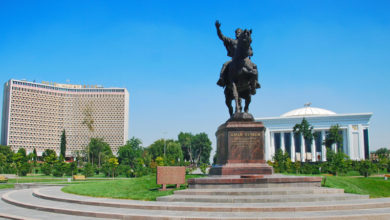UN FAO/GEF natural resources management project continues in Central Asia

In Central Asian countries, there is an ongoing regional project of the UN Food and Agriculture Organization (FAO) and the Global Environment Facility (GEF) on integrated natural resources management. “Integrated natural resources management in drought-prone and salt-affected agricultural production landscapes in Central Asia and Turkey (CACILM-2)”, the five-year project of the FAO and GEF was launched in the end of May 2018 with a budget of over US $75 million. This is one of the largest natural resource initiatives co-financed by participating countries, FAO said on March 26.
This is the second phase of the Central Asian Countries Initiative on Land Management (CACILM-2) regional program, which background was established in 2003, when Kazakhstan, Kyrgyzstan, Tajikistan, Turkmenistan and Uzbekistan agreed to join efforts in responding to the challenges of climate change, the threat of desertification and degradation of fertile soil.
The main objective of this FAO-GEF multi-country project is to widely disseminate and scale up the best technologies and approaches of integrated natural resource management in drought-prone and salt-affected agricultural landscapes of Central Asia and Turkey.
Over the past 50 years, the population of Central Asia has been growing rapidly, its population has tripled and amounted to 74 million in 2020, while more than a half of the population lives in rural areas and depends on agriculture in terms of livelihood.
In extremely vulnerable climatic conditions, with a steady decline in available water resources and the need to feed growing population, the region faces serious challenges in food security and sustainable use of land and water resources, among others.
Climate change undermines agricultural and rangeland productivity in all countries of the region. Pastures, for example, are at risk of desertification due to rising temperatures and reduced precipitation, which directly affects livestock productivity. Another challenge is that rangelands, which occupy between 77 and 95 percent of all agricultural land in the region, are not properly managed.
More than 88 percent of arable land in Kyrgyzstan and 97 percent of agricultural land in Tajikistan are subject to erosion. Productivity on 66 percent of arable land is degrading in Kazakhstan; in Turkmenistan and Uzbekistan this figure reaches 80 percent.
In addition, from 40 to 80 percent of irrigated farmland in the region is subject to salinization or waterlogging, and the highest rates in these areas are observed in Turkmenistan (68 percent) and Uzbekistan (51 percent).
Over the last two years the implementation of project activities continue at 18 pilot areas of Kazakhstan, Kyrgyzstan, Tajikistan, Turkmenistan and Uzbekistan, which were selected on arid, salt-affected regions with prevalent land degradation. On those project demo sites, the project team of experts demonstrate the best technologies and approaches of integrated natural resource management, drought preparedness and conservation agriculture practices.
With support of the Ministry of Agriculture of Kazakhstan, demo sites were selected in 5 regions of Kazakhstan and field works began on demonstration of salt- and drought-tolerant crops, conservation technologies, practices for soil reclamation, as well as on the production of fodder and forage crops, management and restoration of rangeland resources.
In Kyrgyzstan, FAO in partnership with the non-governmental organization Camp Ala-Too, is actively working on strengthening knowledge and capacities of rural communities in Naryn Oblast on sustainable pasture management.
In 4 districts of Tajikistan, initiative groups of women farmers have been formed. They have already begun cultivating salt-tolerant crops in their farms. The groups are designed to disseminate sustainable and climate-friendly land use technologies through Farmer Field Schools.
About forty varieties of drought and salt tolerant crops — plants and trees — were planted at demonstration sites in 4 regions of Uzbekistan using various field technologies. Already 100 farms in the target districts, the heads of which were trained under the project, have begun cultivating drought- and salt-tolerant crop varieties such as corn, African pearl millet, black cumin, sugar sorghum, flax and many others using hydrogel and conservation tillage methods including zero tillage.
In partnership with the Government of Uzbekistan, the project contributes to the implementation of the “Million Fruit Trees” program by arranging the planting of drought-tolerant trees on the dry bottom of the Aral Sea and other semi-desert regions.
In all 5 countries covered by the project, multiple activities are carried out to train government officials, farmers and a wide range of specialists in the field of agricultural production in advanced technologies for the sustainable use of water resources, forecasting droughts, conservation tillage and other approaches that contribute to environmental sustainability in drought-prone and salt-affected agricultural landscapes throughout the region.
In addition, within the framework of the project, a number of scientific and applied research has been completed, or is in the final stage, including in the field of drought risk management, early warning and drought risk management system caused by climate change processes.
For all countries of Central Asia, the project develops special guidelines based on biosaline technologies to sustainably manage land areas prone to soil salinity.
Source: TCA





